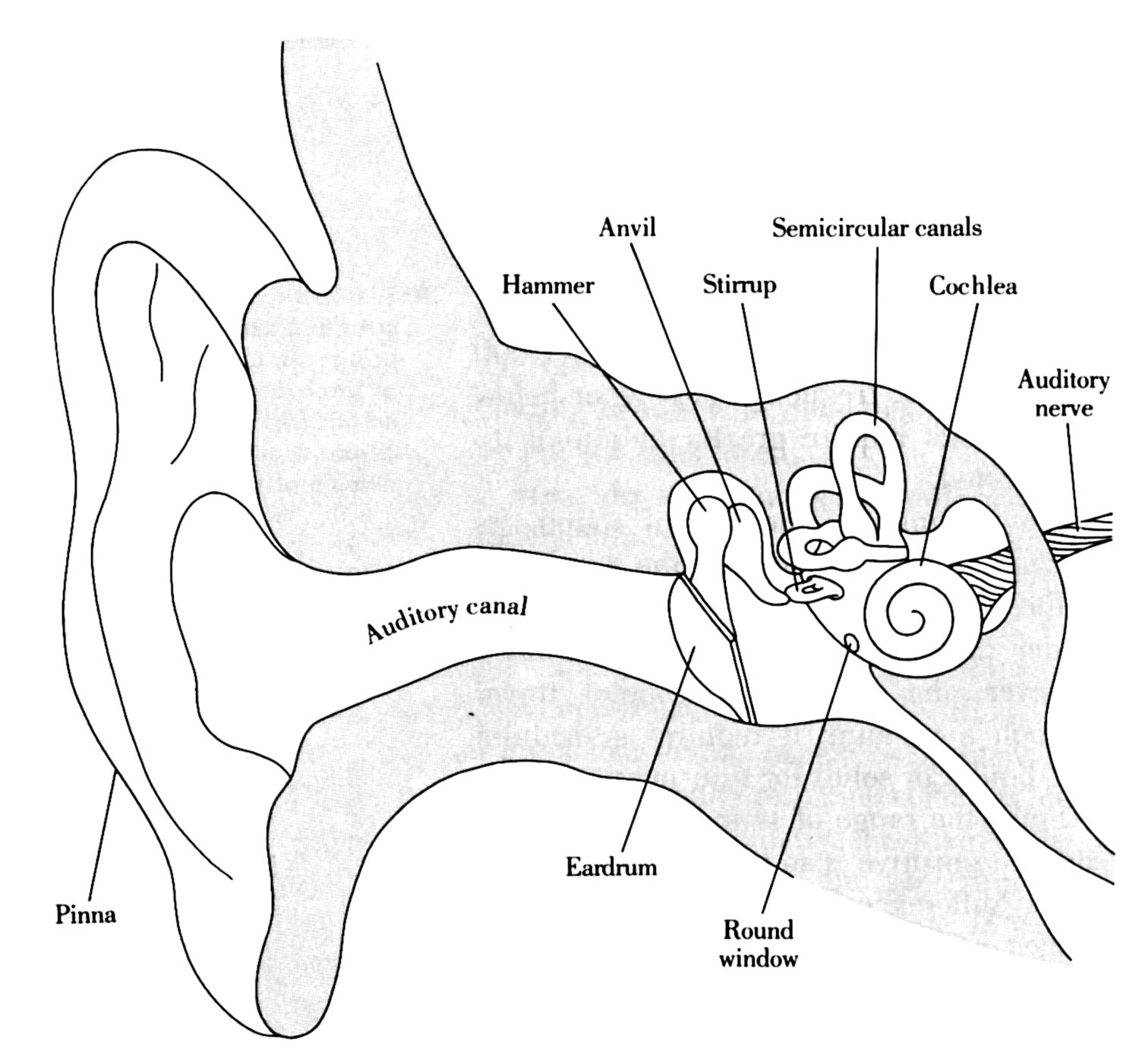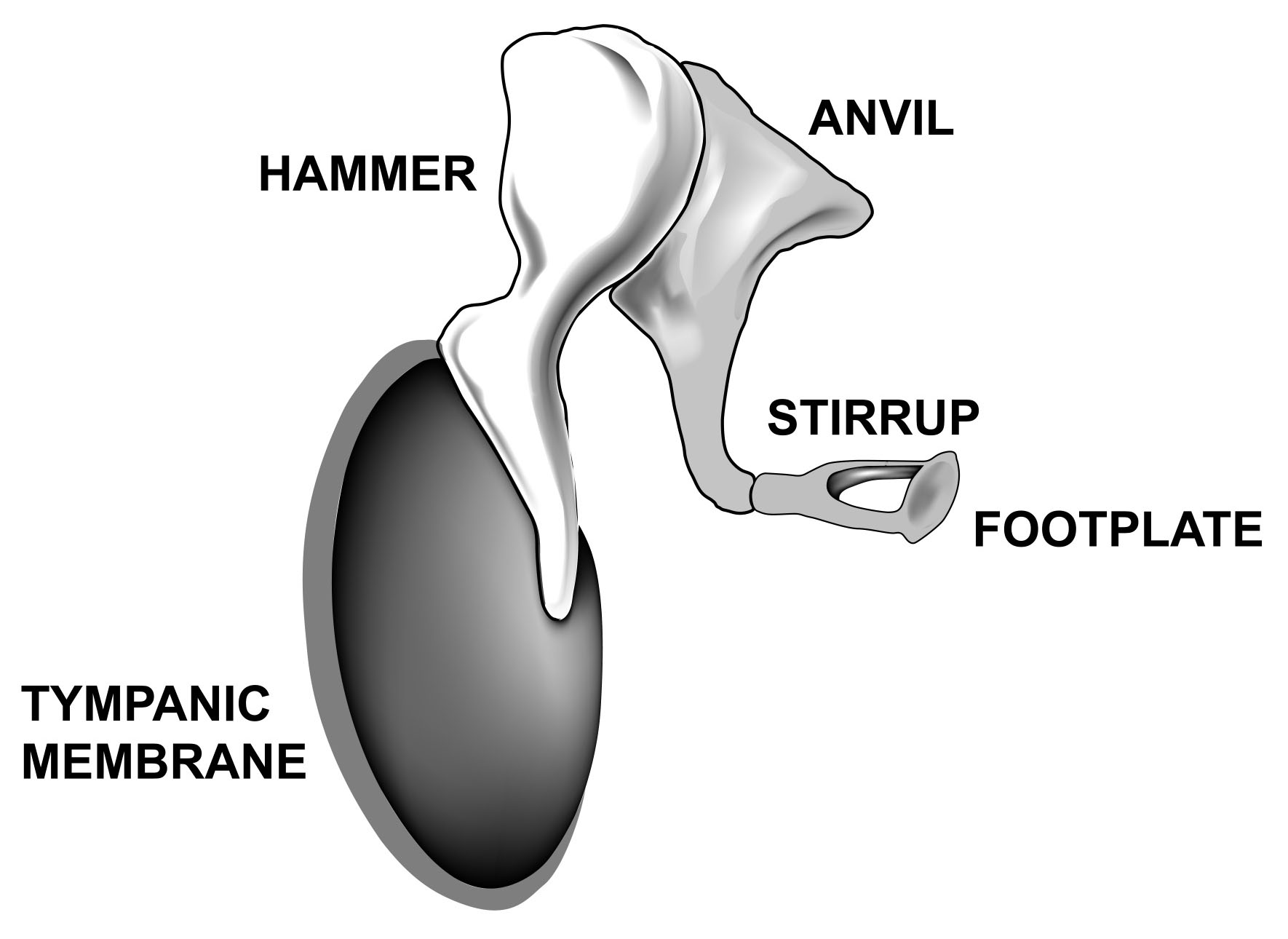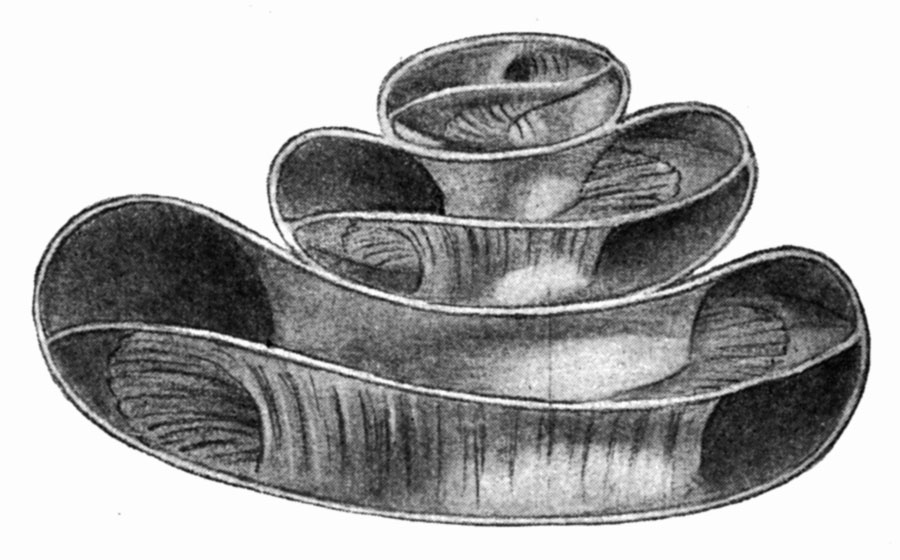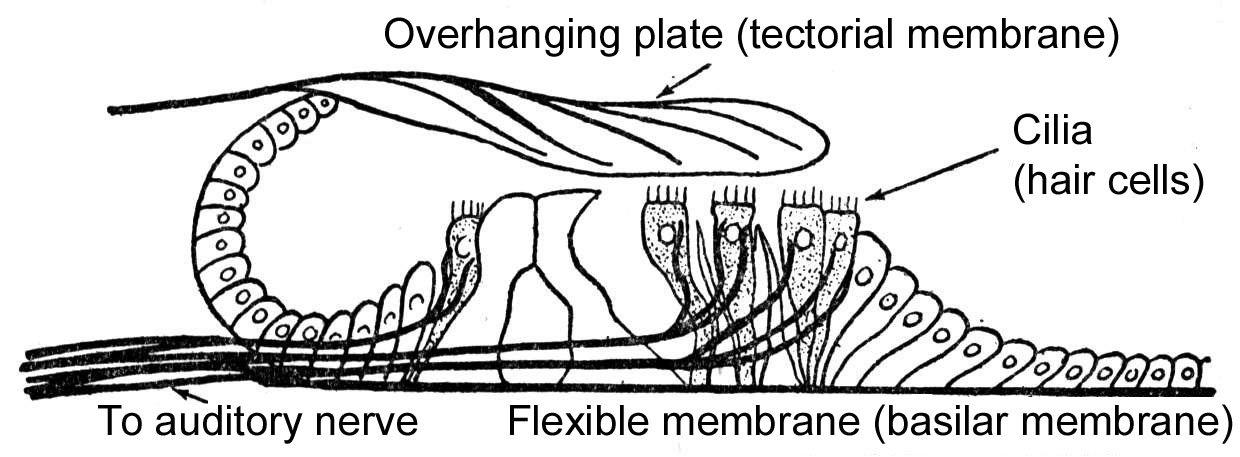Copyright © 2007-2018 Russ Dewey
The Auditory System
While the eye responds to electromagnetic radiation, the ear responds to pressure waves in the air. As explained on the page about receptors and stimulation, sound energy consists of alternating waves of compression and decompression.
Of what does sound consist?
You can feel strong bass notes through touch as well as hearing them. The pressure waves, and the vibrations they create in objects, are strong enough to stimulate touch receptors in human skin.
An audio speaker, like those in stereo systems, produces sound by converting electrical signals into pressure waves. A magnet behind the speaker makes a piston move, and this makes the speaker cone vibrate, creating pressure waves in the air.
When the speaker cone moves forward, it compresses the air; when it moves backward, it decompresses the air. The alternating periods of more pressure and less pressure result in the sensation of sound.
Sound requires a substance to pass through: a medium to compress. There can be no sound of space ships blowing up in outer space, because sound cannot pass through a vacuum.
With rare exceptions such as Stanley Kubrick's 2001: A Space Odyssey, TV series and movies portraying fights between space ships in outer space ignore this simple law of nature. They give viewers the experience they are accustomed to having on earth: hearing explosions.
How are nearly all science fiction movies and TV series inaccurate?
Sometimes you will read about (or hear) the "sounds" of celestial objects, such as spinning stars. In this case, scientists have located an astronomical source of variation in electromagnetic radiation, such as X-rays or visible light.
If the variation occurs at frequencies humans can hear (when they are pressure waves) then scientists can transduce the vibrations into sound to drive a speaker.
Then humans can hear it. There is, nevertheless, no sound propagated through interstellar space.
Sound travels through air, water, and other materials. The denser the medium, the faster sound travels. Sound goes 1,100 feet per second in the air, 4,900 feet per second in water, 20,000 feet per second in steel.
That is why you can detect a train from very far away by putting your ear directly to a rail. Not only is the vibration from a train strong; it travels quickly for a long distance because it is propagated in the rails, a dense medium.
Structures of the Ear
Sound is initially collected by the outer ear, also called the auricle or pinna. This is the visible, fleshy part of the ear. The outer ear is shaped like a funnel, which helps it collect sound.
What is the auricle or pinna?

The human ear in cross-section
Sound enters the outer ear and travels down the auditory canal to the eardrum, which is also called the tympanic membrane. The tympanic membrane is the boundary between the outer and middle ear. Beyond the eardrum is the middle ear.
Within the middle ear are three tiny bones called ossicles, arranged in a chain. The ossicles consist of the hammer (malleus), anvil (incus), and stirrup (stapes, pronounced STAY-peez).

Enlarged view of the ossicles
The ossicles increase the force of vibrations of the tympanic membrane 20-30 times before passing them on to the inner ear. Therefore the middle ear is an amplifying system.
What is the tympanic membrane? What are the ossicles?
In order for the eardrum to move freely and painlessly, the air pressure inside the middle ear should be the same as it is outside. This is accomplished naturally in the body by venting the middle ear to the back of the throat through a small tube, the Eustachian tube.
The Eustachian tube (technically known as the pharyngotympanic or auditory tube) opens to equalize middle ear pressure each time you swallow. If you blow too hard on a balloon, the pressure will sometimes go up your Eustachian tube and cause pain in the middle ear.
What is the function of the Eustachian tube?
Sometimes you need to equalize the pressure in the middle ear but the Eustachian tube stubbornly refuses to open. This causes a feeling of pressure in the ears.
For example, if you ride a car up a mountain road, the air pressure outside drops and your eardrum bulges outward. Your ears feel funny, as though stuffed with cotton.
To "clear your ears" you must open the Eustachian tube by chewing gum or yawning. Unfortunately, it is difficult to produce a real yawn when you need one.
Deliberate yawning movements may not work. If a genuine yawn occurs, the tube opens and the pressure equalizes, sometimes with a little popping sound.
The Inner Ear
The inner ear lies beyond the ossicles. The oval window is the boundary between the middle and inner ear, just as the eardrum (tympanic membrane) is between the outer and middle ear.
The inner ear is filled with fluid and encased in some of the hardest bone of the skull. The main organ of the inner ear is the cochlea, a snail-shaped structure.
The cochlea is a transducer, which means it is a system for converting energy from one form into another. The cochlea transduces mechanical vibrations of sound into nerve impulses.
How does the cochlea transduce pressure waves into nerve impulses? Throughout its entire length the cochlea is divided into several parallel channels filled with fluid.

The cochlea contains long channels coiled into a shape like a snail shell.
In this picture the artist shows a single, empty channel to highlight the spiral shape of the cochlea. In reality, the channel is divided into several smaller chambers, and it contains delicate structures.
What is the cochlea? How does the cochlea act as a transducer?
Sound vibrations produce ripples in the fluid within the channels. Superimposed on tiny, fast vibrations of the fluid are larger, slower waves called traveling waves.
Georg von Bekesy won the Nobel Prize in 1961 for research on the cochlea. He showed that traveling waves in the cochlea peak at different locations, depending on frequency.
The basilar membrane is a thin sheet of tissue that runs the length of the cochlea. It is surrounded by channels of fluid where traveling waves occur.
Along the basilar membrane is an elaborate structure called the Organ of Corti. It contains tiny hair cells that touch an overhanging shelf, the tectorial membrane.

Tiny hair cells (cilia) are vibrated by the basilar membrane.
The hair cells are bent when the basilar membrane and surrounding fluids are distorted by traveling waves. When a hair is bent, it generates an electrical impulse that triggers nerve impulses along the auditory nerve leading to the brain.
Where are the receptors for the sense of hearing? How are mechanoreceptors involved in the sense of hearing?
Therefore, in a sense, the sense of hearing is based on touch. The receptor cells for the sense of hearing are mechanoreceptors (hair cells in the Organ of Corti).
Cochlear Implants
There are several causes of deafness. Only one type, conductive deafness due to bony growths on the ossicles, can be treated with surgery. Until recent decades there was no treatment for nerve deafness, which is due to disorders in the cochlear system.
In the 1980s, scientists found that the hair cells inside the cochlea could be bypassed. Nerve cells could be stimulated directly at several places along the length of the cochlea.
This made it possible for a person with nerve deafness to hear sounds. Cochlear implants are devices that convert sounds into electrical stimulation for nerve cells of the cochlea
What is a cochlear implant?
Initial efforts to stimulate the cochlea were not very successful. Schmeck (1984) reported how one patient, totally deaf for a year, was given an early version of the cochlear implant.
He reported that his own voice sounded to him "like a bunch of Martians." He was "far from being able to understand conversational speech."
Since then, cochlear implants have come a long way. The most important improvement was the introduction of microprocessors: small computers located within the implant.
Microprocessors enhance the frequencies of sound most useful for speech and help to screen out less useful noise. By the 2000s implants were very useful for improving speech perception in certain cases, although they typically required special equipment be worn outside the body.
Further refinements minimized the size of external microphones and processors. Now cochlear implants are no more visible than other hearing aids.
What refinements in technology are improving performance of such implants?
Cochlear implants are controversial in the deaf community. Many deaf parents prefer to have their children grow up in the cultural traditions of the deaf community.
Sign language is just as rich and expressive as spoken language. Deaf people resent the implication that deafness is a defect that needs to be fixed. A deaf child can have a full, happy life without cochlear implants.
Parents who are not deaf themselves are more likely to want cochlear implants for a child who is deaf. Geers and Nicholas (2013) reported that deaf children receiving cochlear implants before 18 months of age developed age-appropriate language skills, learning to speak and hear language normally.
Frequency Sensitivity of Human Hearing
A human with perfect hearing can detect sounds from about 20-20,000 cycles per second (Hertz). Above about 15,000 Hz, sounds are difficult to hear as isolated tones.
People can often detect a difference between two sound sources if one includes frequencies above 15,000 Hz and the other does not. The recording with more high frequencies will sound brighter and have more presence. (Music with "presence" sounds more like somebody actually in front of you.)
What is a normal frequency range for adult human hearing?
Music can still be enjoyable with the very highest frequencies missing. FM radio stations do not transmit sound information above 15,000 Hz.
Dogs can hear ultrasonic sounds, frequencies higher than humans can normally detect. That is why dog whistles can be silent to humans.
Cats hear sounds up to 50,000 Hz, porpoises up to 80,000, and bats–the champions–hear sounds up to 98,000 Hz. Bats use extremely high-frequency sounds as a navigational sonar, bouncing sound waves off objects in the dark to avoid obstacles and detect insects.
Humans, too, can learn to use high-frequency reflections for navigational sonar. One blind teenager was shown on TV demonstrating this ability.
It was not perfect, but he could avoid obstacles well enough to ride a bicycle and skateboard without assistance. He made very high pitched clicks using his tongue on the roof of his mouth and listened for echoes.
Sensitivity to high frequency tones lessens with age. Teenagers can hear very high tones that older adults, even in their 20s, are unlikely to detect.
This led a Welsh security firm to develop a device called the Mosquito. It was designed to deter teenagers from loitering around areas such as store fronts by emitting an annoying high pitched tone only teenagers could hear.
Within a year, teenagers had turned this effect to their own advantage. They developed ringtones for cell phones that only teenagers could hear (Vitello, 2006). These are still available online with names like "stealth tone."
---------------------
References:
Geers, A. E. & Nicholas, J. G. (2013). Spoken language benefits of extending cochlear implant candidacy below 12 months of age. Otology & Neurotology, 34, 532-538.
Vitello, P. (2006, June 12) New York Times. Retrieved from: https://www.nytimes.com/
Write to Dr. Dewey at psywww@gmail.com.
Don't see what you need? Psych Web has over 1,000 pages, so it may be elsewhere on the site. Do a site-specific Google search using the box below.
